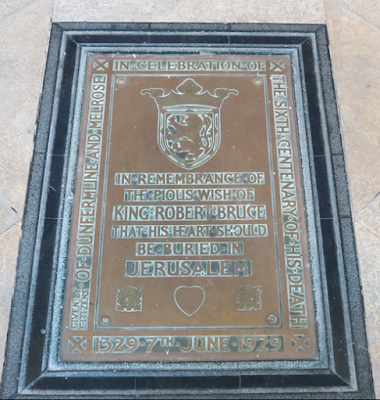The Braveheart That Was Almost Buried in Jerusalem

In the successful film "Braveheart" Mel Gibson portrays the character of the 13th century Scottish national hero William Wallace, who led the Scots in their first war of independence against the English king Edward I "Longshanks" (who was also called “Hammer of the Scots”...). Another central character in the film is that of Robert the Bruce, the Scottish nobleman who won Wallace's support and later became King Robert I of Scotland. Robert also defeated the English under the leadership of King Edward II, son of Edward "Longshanks", at the historic Battle of Bannockburn in 1314.
Robert died in 1329, apparently from leprosy, and requested in his will that his heart be buried in Jerusalem. The heart was given to the knight James Douglas "the black" who took it with him when he left for the Holy Land. Unfortunately for the Scottish king, his knight was killed in a battle with Muslims in Spain during the journey and was unable to complete his mission. The royal heart was returned to Scotland and all traces of it disappeared. In 1921, a container was discovered in the Melrose Abbey, on which it is written that it contains the heart of the Scottish king, and it lies there to this day. In the early 19th century, Robert's grave was also discovered in the Dunfermline Abbey, and it turned out that the skeleton's sternum had been sawn lengthwise - indicating that the king's heart was indeed removed from his body after his death.
St. Andrew's Church, also known as the Scottish Church, is located on a hill in front of Mount Zion near the historic Jerusalem train station and the Jerusalem Khan. It was built between 1927-1930 during the British Mandate to commemorate the Scottish soldiers who served in the British Army and were killed in the First World War, and is named after the patron saint of Scotland, Saint Andrew. The cornerstone of the church was laid by General Allenby, conqueror of Jerusalem and the land of Israel from the Ottomans.
The church was designed by the British architect Clifford Holliday, who was one of the most important planners of modern Jerusalem during the Mandate period, and it combines Western and Eastern motifs. In the church building, a special stone was used that absorbs lichens, so that it will look old quickly and give the church an ancient appearance.
Although the church is relatively new, it preserves the ancient tradition related to the heart of King Robert too. The heart itself is buried as mentioned in Scotland, but the church in Jerusalem has a memorial plaque that indicates its story. Since the church commemorates the slain British soldiers, two British sniffer dogs who took part in the fighting are also buried in its courtyard. One of these dogs was named Bruce, after the Scottish king whose heart remains in his faraway homeland.

(Anecdote authored by: עמיר)
(Number of views: 54)
